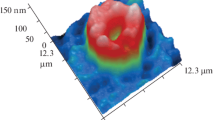Summary
Combined cytometric studies and control of blood coagulation of a cold injury brain edema in the left parietal cortex (cortical layers I and II) of rabbits had the following results: a) Within the first 30 min after the lesion, a hypocoagulability was observed only in the cerebral vessels and significant correlations are limited to the changes between the nuclear size of endothelial, glial and nerve cells of the left, lesioned, cortical area. An increase, however, in the diameter of the cytoplasmic profiles of the endothelial cells and of the pericapillary glial end feet of the right cortical layer II can be interpreted as an early reaction of these cell types to the disturbed function of the lesioned cortical area. b) 60 min after the lesion there is a general hypercoagulability which is followed by a general hypocoagulability 12 hrs later. Endothelial, glial and nerve cells of the right hemisphere are more and more influenced by the increasing edema of the left hemisphere (for correlations see p. 16). It is suggested that the changes of permeability in the lesioned hemisphere locally affect blood coagulation and thus have an influence via the cerebral vessels on the function of nerve cell-glia complexes in the contralateral hemisphere.
Similar content being viewed by others
Literatur
Bakay, L., Lee, J. C.: Cerebral edema. Springfield: C. C. Thomas 1965
Bingham, W. G., Paul, S. E., Sastry, K. S. S.: Effect of cold injury on six enzymes in rat brain. Arch. Neurol. (Chic.)21, 649–660 (1969)
Cobb, S.: Cerebrospinal blood vessels. In: Cytology and cellular pathology of the nervous system (Penfield, W.), vol. II, W., pp. 518–610. New York: P. B. Hoeber 1932
Hardaway, R. M.: Hemodynamic compensation as therapy of microcirculatory disturbance. In: Microcirculation, hemostasis and shock. Symposium, Schloß Reinhartshausen/Rhein. October 3rd/4th 1969 (Lasch, H.-G. and Heene, D. L.), pp. 135–140. Stuttgart-New York: Schattauer 1970
Kappers, Ariëns, C. U.: Die vergleichende Anatomie des Nervensystems der Wirbeltiere und des Menschen. II. Abschn.: Vergleichende Anatomie des Kleinhirns, des Mittel- und Zwischenhirns und des Vorderhirns, pp. 1118–1255. Haarlem: De Erven F. Bohn 1921
Kraus, H.: Probleme der Blutgerinnungsstörungen in der Neurochirurgie. Acta neurochir. (Wien)20, 123–130 (1969)
Lasch, H.-G., Rodriguez-Erdmann, F., Schütterle, G., Sessner, H. H.: Verbrauchskoagulopathie. Folia haemat. (Frankfurt)6, 325 (1961)
Lee, J. C., Bakay, L.: Ultrastructural changes in the edematous central nervous system. II. Cold induced edema. Arch. Neurol. (Chic.)14, 36–49 (1966)
Oksche, A., Zimmermann, P., Oehmke, H.-J.: Morphometric studies of tubero-eminential systems controlling reproductive functions. In: Brain-endocrine interaction. Median eminence: Structure and function. Int. Symp. Munich 1971, pp. 142–153. Basel: Karger 1972
Opitz, E., Schneider, M.: Über die Sauerstoffversorgung des Gehirns und den Mechanismus der Mangelwirkung. Ergebn. Physiol.46, 126–260 (1950)
Reulen, H. J., Steude, U., Brendel, W., Hilber, C., Prusiner, S.: Energetische Störung des Kationentransports als Ursache des intracellulären Hirnödems. Acta neurochir. (Wien)22, 129–166 (1970)
Ryder, H. W., Espey, F. F., Kimball, F. D., Penka, E. J., Rosenauer, A., Podolsky, B., Evans, J. P.: The mechanism of the change in cerebrospinal fluid pressure following an induced change in the volume of the fluid space. J. Lab. clin. Med.41, 428–435 (1953)
Sachs, L.: Statistische Arbeitsmethoden. Berlin-Heidelberg-New York: Springer 1972
Scholz, W.: Histologische und topische Veränderungen und Vulnerabilitätsverhältnisse im menschlichen Gehrin bei Sauerstoffmangel, Ödem und plasmatische Infiltrationen. Arch. Psychiat. Nervenkr.181, 621–665 (1949)
Schröer, H., Hauck, G.: Influence of blood clotting potential on the barrier function of the vessel wall. 5th Europ. Conf. Microcirculation Gothenburg, 1968. Bibl. anat. (Basel)10, 418–423 (1969)
Torack, R. M., Terry, R. D., Zimmermann, H. M.: The fine structure of cerebral fluid accumulation. I. Swelling secondary to cold injury. Amer. J. Path.35, 1135–1147 (1959)
Warren, B. A.: Fibrinolytic activity of vascular endothelium. Brit. med. Bull.20, 213–216 (1964)
Weibel, E. R., Elias, H.: Quantitative methods in morphology. Berlin-Heidelberg-New York: Springer 1967
Zimmermann, P.: Methodische Modifikationen und eine neue Technik zur Darstellung des neurosekretorischen Apparates und der Neuroglia bei Wirbellosen (Lumbricus terrestris L.). Z. wiss. Mikr.68, 154–162 (1967)
Zimmermann, P., Paul, E.: Reaktionsmuster verschiedener Mittel- und Zwischenhirnzentren nach Unterbrechung der Nervenbahnen des Pinealkomplexes vonRana temporaria. Z. Zellforsch.128, 512–537 (1972)
Author information
Authors and Affiliations
Additional information
Mit Unterstützung durch die Deutsche Forschungsgemeinschaft.
Rights and permissions
About this article
Cite this article
Zimmermann, P., Gagel, C., Zimmermann, H. et al. Kälteinduzierte Ödem- und Nekroseentwicklung im Parietalcortex von Kaninchen. Acta Neuropathol 29, 157–174 (1974). https://doi.org/10.1007/BF00684774
Received:
Accepted:
Issue Date:
DOI: https://doi.org/10.1007/BF00684774




